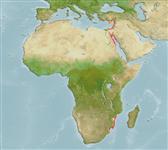Common names from other countries
Environment: milieu / climate zone / depth range / distribution range
Οικολογία
; εύρος βάθους 1 - 100 m (Ref. 83938). Tropical; 46°N - 30°S, 32°E - 37°E (Ref. 275)
Circumglobal in warm to temperate waters.
Length at first maturity / Μέγεθος / Βάρος / Age
Maturity: Lm ? range ? - ? cm Max length : 18.0 cm ML αρσενικό/απροσδιόριστο; (Ref. 105659); common length : 80.0 cm TL αρσενικό/απροσδιόριστο; (Ref. 417); μεγ. δημοσιευμένο βάρος: 2.0 kg (Ref. 275)
Minimum depth from Ref. 104052. Also caught by artisanal fishing gears (spears, hooks, lures, and traps; Ref. 417). Maximum total length ranges from 120 to 150 cm (Ref. 3722). Found in coralline bottoms (Ref. 417), coral reefs, sandy and rubble bottoms, particularly in subtidal areas (Ref. 83938).
Life cycle and mating behavior
Γεννητική Ωρίμανση | Αναπαραγωγή | Γεννοβολία | Αβγά | Γονιμότητα | Προνύμφες
Members of the class Cephalopoda are gonochoric. Male and female adults usually die shortly after spawning and brooding, respectively. Mating behavior: Males perform various displays to attract potential females for copulation. During copulation, male grasp the female and inserts the hectocotylus into the female's mantle cavity where fertilization usually occurs. Life cycle: Embryos hatch into planktonic stage and live for some time before they grow larger and take up a benthic existence as adults.
Schneider, W. 1990. (Ref. 417)
IUCN Red List Status (Ref. 130435)
CITES status (Ref. 108899)
Not Evaluated
Not Evaluated
Human uses
αλιεία: Εμπορικό(ά)
| FishSource | Η θάλασσα γύρω μας
Εργαλεία
Περισσότερες πληροφορίες
Age/SizeΑύξησηLength-weightLength-lengthΜορφολογίαΠρονύμφεςΑφθονία
Διαδικτυακές πηγές
Estimates based on models
Preferred temperature
(Ref.
115969): 20.3 - 26.4, mean 24.5 (based on 60 cells).
Vulnerability
Low vulnerability (10 of 100).
